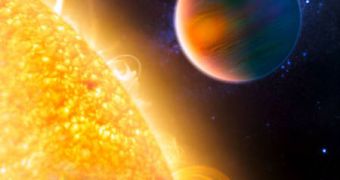Usually, in all star systems thus far discovered that feature exoplanets, all planets, moons and other bodies revolve around the central star in an orbit that has the same orientation as the spin of the star. This was so far believed to be a basic rule of the way the Universe was set up, but this theory was thrown out the window once astronomers found an exoplanet orbiting in the opposite direction than the spin of its star. The system, WASP-17, is located about 1,000 light-years away from Earth, Space informs.
The find, which was not yet published in any scientific journals, was made through a collaborative effort by astronomers involved in the United Kingdom's Wide Area Search for Planets (WASP) project, and experts at the Geneva Observatory, in Switzerland. Stars are known to form when a cloud of cosmic dust and gas collapses on itself. The formation then starts spinning, and the newly formed body at one point begins its massive reactions that generate all forms of radiation.
Planets are suspected to form in about the same way, from the remains of these clouds. Given the fact that the spin of the formed star is also the spin of the proto-planetary disks, it would stand to reason that the planets have exactly the same spin as the object at the center of their system. But astronomers believe that, in the case of WASP-17, it may be that a larger planet acted on the one currently orbiting backwards, and that the extreme gravitational interference may have caused a slingshot effect that set the planet on its existing course.
According to astronomers, the new object is about the mass of the planet Jupiter, but it is “artificially” inflated to twice its size. That is to say, it is currently orbiting its star on a highly elliptical orbit. This means that it gets to pass very close to the star and then move very far from it. The strong gravitational forces that occur when this happens pull it apart. “This planet is only as dense as expanded polystyrene, 70 times less dense than the planet we're standing on,” explains Keele University expert, Professor Coel Hellier.

 14 DAY TRIAL //
14 DAY TRIAL //